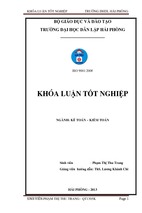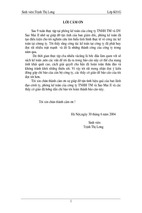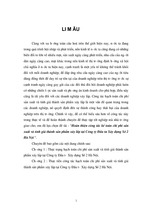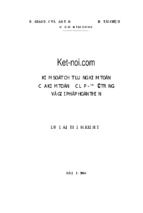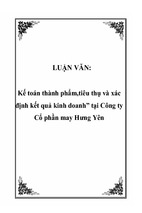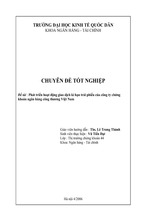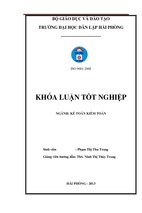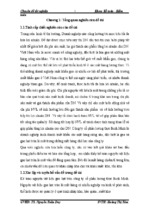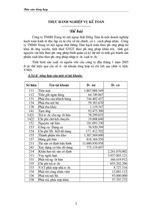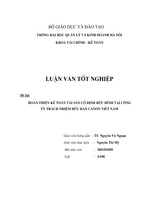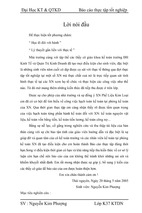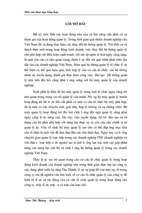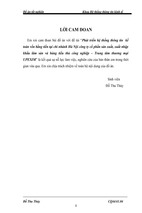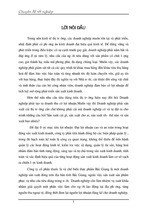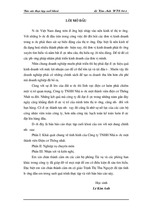Mô tả:
Tài liệu CAT T1- hạch toán các giao dịch tài chính
Introductory
Paper 1
RECORDING FINANCIAL
TRANSACTIONS
(INTERNATIONAL STREAM)
In this January 2008 new edition
• Updated for IAS 1 (revised)
• Do you know? Checklists to test your knowledge and understanding of topics
• A question and answer bank
• The ACCA's pilot paper as a mock exam
P
R
A
C
T
I
C
E
&
R
E
V
I
S
I
O
N
BPP's i-Pass product also supports this paper.
K
I
T
FOR EXAMS IN 2008
First edition 2004
Fifth edition January 2008
ISBN 9780 7517 4816 1 (previous ISBN 9780 7517 3564 2)
British Library Cataloguing-in-Publication Data
A catalogue record for this book
is available from the British Library
Published by
BPP Learning Media Ltd
BPP House, Aldine Place
London W12 8AA
www.bpp.com/learningmedia
Printed in Great Britain by
W M Print
Fredrick Street
Walsall
WS2 9NE
Your learning materials, published by BPP Learning
Media Ltd, are printed on paper sourced from
sustainable, managed forests.
ii
All our rights reserved. No part of this publication may be
reproduced, stored in a retrieval system or transmitted, in
any form or by any means, electronic, mechanical,
photocopying, recording or otherwise, without the prior
written permission of BPP Learning Media Ltd
We are grateful to the Association of Chartered Certified
Accountants for permission to reproduce past
examination questions. The answers to past examination
questions have been prepared by BPP Learning Media
Ltd, unless where otherwise stated
©
BPP Learning Media Ltd
2008
Contents
Page
Question index........................................................................................................................................................ iv
Using your BPP Practice and Revision Kit ............................................................................................. vi
Important information for students sitting this exam in 2008 ...................................................... ix
Passing CAT exams
How to revise ................................................................................................................................................................ xiii
How NOT to revise ......................................................................................................................................................... xiv
How to PASS your exam ................................................................................................................................................. xv
How NOT to PASS your exam ........................................................................................................................................ xvi
Syllabus ........................................................................................................................................................................ xvii
Approach to examining the Syllabus .............................................................................................................................xxiv
The Computer Based Examination..................................................................................................................................xxv
Tackling Multiple Choice Questions..............................................................................................................................xxvi
Using your BPP products.............................................................................................................................................xxvii
Questions and answers
Questions..........................................................................................................................................................................3
Answers ..........................................................................................................................................................................37
Exam practice
Practice questions and answers
•
Questions ..............................................................................................................................................................61
•
Answers.................................................................................................................................................................73
Mock exam
•
Questions ..............................................................................................................................................................81
•
Answers.................................................................................................................................................................95
Review form & free prize draw
iii
QUESTION INDEX
Question index
Time
Page number
Marks
allocation
Mins
Question
Answer
16
19
5
37
9–15
14
17
7
38
16–23
16
19
8
39
24–38
30
36
9
41
39
2
2
11
43
40–44
10
12
15
44
45–49
10
12
15
44
50–54
10
12
16
45
55–62
16
19
17
46
63–68
12
14
18
47
69–74
12
14
19
48
75–79
10
12
20
49
Part A: Introduction to transaction accounting
Business transactions and documentation
Objective test questions
1–8
Assets, liabilities and the accounting equation
Objective test questions
Balance sheet and profit and loss account
Objective test questions
Recording, summarising and posting transactions
Objective test questions
Completing ledger accounts
Objective test question
Part B: Recording and accounting for cash
transactions
Receiving and checking money
Objective test questions
Banking monies received
Objective test questions
Recording monies received
Objective test questions
Authorising and making payments
Objective test questions
Recording payments
Objective test questions
Maintaining petty cash records
Objective test questions
Bank reconciliations
Objective test questions
iv
QUESTION INDEX
Part C: Recording and accounting for credit
transactions
The receivables ledger
Objective test questions
80–86
14
17
23
51
87–89
6
7
24
52
90–106
34
41
24
52
107–115
18
22
33
57
The payables ledger
Objective test questions
Control accounts and the trial balance
Objective test questions
Part D: Payroll
Recording payroll transactions
Objective test questions
Practice questions and answers
Mixed bank 116–165
Mock exam
Pilot paper 166–215
v
QUESTION INDEX
Using your BPP Practice and Revision Kit
Aim of this Practice & Revision Kit
To provide the practice to help you succeed in both the paper based and computer based examinations for Paper 1
Recording Financial Transactions (International).
To pass the examination you need a thorough understanding in all areas covered by the syllabus and teaching guide.
Recommended approach
•
Make sure you are able to answer questions on everything specified by the syllabus and teaching guide. You
cannot make any assumptions about what questions may come up on your paper. The examiners aim to
discourage 'question spotting'. In a paper that has objective test questions or a number of shorter
questions, the examiner has the opportunity to test a wide area of the syllabus. Where there are long
questions, a number of different issues can be brought in. And an area that has been tested in one sitting
can still be tested again in the next sitting.
•
Learning is an active process. Use the DO YOU KNOW? Checklists to test your knowledge and
understanding of the topics covered in Paper 1 Recording Financial Transactions (International) by filling in
the blank spaces. Then check your answers against the DID YOU KNOW? Checklists. Do not attempt any
questions if you are unable to fill in any of the blanks - go back to your BPP Interactive Text and revise first.
•
When you are revising a topic, think about the mistakes that you know that you should avoid by writing
down POSSIBLE PITFALLS at the end of each DO YOU KNOW? Checklist.
•
Once you have completed the checklists successfully, you should attempt the questions on that topic. Each
section has a selection of OBJECTIVE TEST QUESTIONS and COMPULSORY WRITTEN QUESTIONS. Make
good use of the HELPING HANDS provided to help you answer the questions. On questions that have been
in past exam papers, we report 'what the examiner said'. This shows you how students who sat the exam
coped with the question and tells you what the pitfalls were and what the examiner was looking for.
•
There is a mark allocation for each compulsory written question. Each mark carries with it a time allocation
of 1.2 minutes (including time for selecting and reading questions). A 15 mark question therefore should be
completed in 18 minutes. For papers 6–10 each mark carries a time allocation of 1.8 minutes.
•
Once you have completed all of the questions in the body of this Practice & Revision Kit, you should attempt
the MOCK EXAMS under examination conditions. These are the latest actual exams. Check your answers
against our answers and apply the ACCA's Official marking scheme to find out how well you did.
Please see the next section for important information concerning the 2008 exams.
vi
Important information
vii
viii
IMPORTANT INFORMATION
Important information for students sitting this exam in 2008
IAS 1 was revised in September 2007. This mainly affects terminology used in financial statements.
This does not really affect CAT Paper 1 International apart from the ‘balance sheet’ may be called the ‘statement of
financial position’.
In this kit, we have shown both terms. Your examiner may use either.
ix
IMPORTANT INFORMATION
x
Passing CAT exams
xi
xii
PASSING CAT EXAMS
How to revise
; Plan your revision
At the start of your revision period, you should draw up a timetable to plan how long you will spend on each
subject and how you will revise each area. You need to consider the total time you have available and also the time
that will be required to revise for other exams you’re taking.
; Practise Practise Practise
The more questions you do, the more likely you are to pass the exam. Practising questions will mean that you’ll
get used to the time pressure of the exam. When the time is up, you should note where you’ve got to and see how
many questions you have completed.
; Revise enough
Make sure that your revision covers the breadth of the syllabus, as any topic an come up. However it is true that
some topics are key – they are an important part of the syllabus or are a particular interest of the examiner – and
you need to spend sufficient time revising these.
; Deal with your difficulties
Difficult areas are topics you find dull and pointless, or subjects that you found problematic when you were
studying them. You mustn’t become negative about these topics; instead you should build up your knowledge by
reading the Passcards and using the Quick quiz questions in the Study Text to test yourself. When practising
questions in the Kit, go back to the Text if you’re struggling.
; Learn from your mistakes
Having completed a question you must try to look at your answer critically. As you go through the Kit, it’s worth
noting any traps you’ve fallen into and referring to these notes in the days before the exam. Aim to learn at least one
new point from each question you attempt.
; Complete the mock exam
You should attempt the Mock exam at the end of the Kit under strict exam conditions, to gain experience of
managing your time and producing answers.
xiii
PASSING CAT EXAMS
How NOT to revise
: Revise selectively
Examiners are well aware that some students try to forecast the contents of exams, and only revise those areas that
they think will be examined. In CBA questions come up in a random fashion and you cannot predict what will come
up.
: Spend all the revision period reading
You cannot pass the exam just by learning the contents of Passcards, Course Notes or Study Texts. You have to
develop your application skills by practising questions.
: Audit the answers
This means reading the answers and guidance without having attempted the questions. Auditing the answers gives
you false reassurance that you would have tackled the questions in the best way and made the points that our
answers do. The feedback we give in our answers will mean more to you if you’ve attempted the questions and
thought through the issues.
: Get bogged down
Don’t spend a lot of time worrying about all the minute detail of certain topic areas, and leave yourself insufficient
time to cover the rest of the syllabus. Remember that a key skill in the exam is the ability to concentrate on what’s
important and this applies to your revision as well.
: Overdo studying
Studying for too long without interruption will mean your studying becomes less effective. A five minute break each
hour will help. You should also make sure that you are leading a healthy lifestyle (proper meals, good sleep and
some times when you’re not studying).
xiv
PASSING CAT EXAMS
How to PASS your exam
; Prepare for the day
Make sure you set at least one alarm (or get an alarm call), and allow plenty of time to get to the exam hall. You
should have your route planned in advance and should listen on the radio for potential travel problems. You should
check the night before to see that you have pens, pencils, erasers, watch, calculator with spare batteries, also exam
documentation and evidence of identity.
; Plan your time
You need to make sure that you will be answering the correct number of questions, and that you spend the right
length of time on each question – this will be determined by the number of marks available. Papers 1–5 are 2 hour
papers, so each mark carries a time allocation of 1.2 minutes. This means that a 2-mark question should be
completed in 2.4 minutes.
; Read the questions carefully
To score well, you must follow the requirements of the question, understanding what aspects of the subject area
are being covered, and the tasks you will have to carry out.
; Stay until the end of the exam
Use any spare time to check and recheck your script. This includes checking you have filled out the candidate
details correctly, you have labelled question parts and workings clearly, you have used headers and underlining
effectively and spelling, grammar and arithmetic are correct.
xv
PASSING CAT EXAMS
How NOT to Pass your exam
: Don’t do enough questions
If you don’t attempt sufficient questions on the paper, you are making it harder for yourself to pass the exam on the
questions that you do attempt. Failing to attempt all of the paper is symptomatic of poor time management.
: Rush through the questions without thinking about them properly
If you don't understand a question, read it again before you start guessing.
: Get bogged down
Each question is only worth 2 marks. If you really can't do it, move on.
xvi
PASSING CAT EXAMS
Syllabus
xvii
PASSING CAT EXAMS
xviii
PASSING CAT EXAMS
xix
PASSING CAT EXAMS
xx
- Xem thêm -

